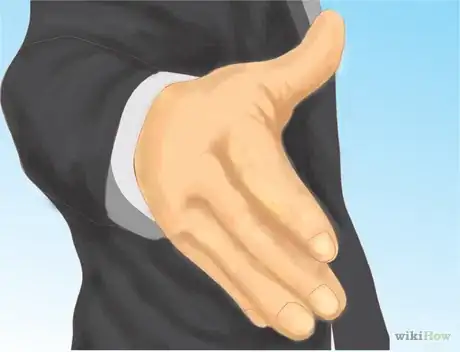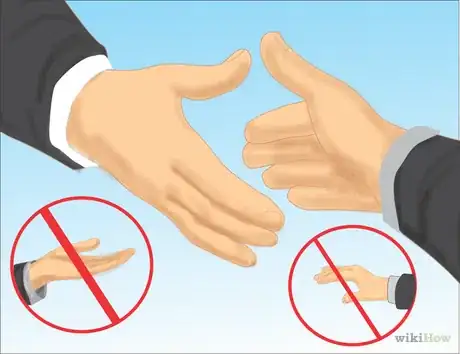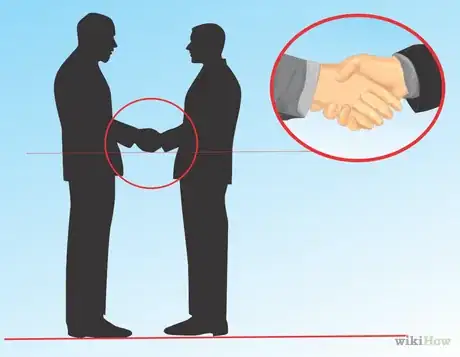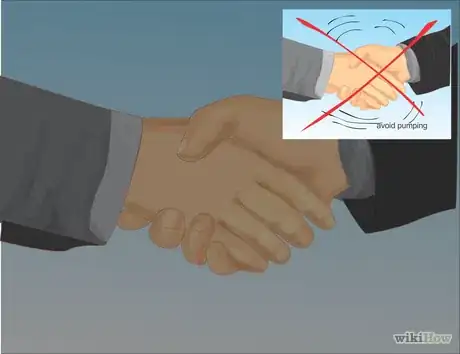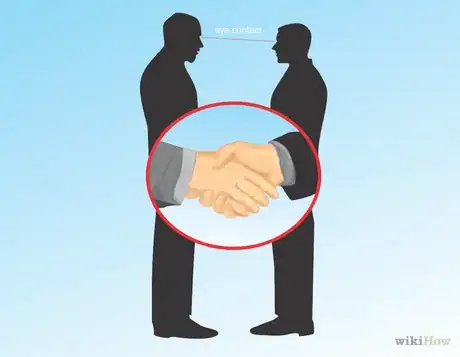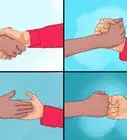X
wikiHow is a “wiki,” similar to Wikipedia, which means that many of our articles are co-written by multiple authors. To create this article, 23 people, some anonymous, worked to edit and improve it over time.
This article has been viewed 141,841 times.
Learn more...
For those cultures that value the handshake, much meaning is transferred by the manner in which you proffer your hand and the method with which you shake the other person's hand. Some people make instant judgments about your character as a result of your handshake, so it pays to make sure it's conveying what you want it to.
Steps
-
1Know when to use your handshake. The appropriate times to shake another person's hand include:
- When you are introduced to someone
- When you say goodbye to someone
- At the beginning or the end of a business, social, church, or other meeting
- Whenever it seems appropriate within a business context, such as sealing a deal.
-
2Be the first to extend your hand. This makes a strong, lasting impression on the person at the receiving end. It is also about control; by offering your hand first, you are leading the way. This applies to both men and women; don't shy away for reasons of being coy or putting yourself down.
- The only time that you should not seek to be so affable as to offer to shake first is where there is an authority structure in place that should be adhered to. For example, if there is a more senior or higher-ranked person in a social gathering, work or business context, follow the lead of the higher ranked person (President, Governor-General, CEO etc.).
Advertisement -
3Extend your right hand straight before the handshake. Do not have your palm facing either up or down; the palm should meet with the palm of the other person.
- The exception to using the right hand is if you don't have one, if it is paralyzed or otherwise seriously injured.
-
4Take the other person's hand in a firm but not rock-hard clasp. Make sure that the web located between your thumb and fingers meets the web of the other person's hand.
-
5Keep your hand parallel to the ground. Do not roll it sideways for the handshake. Keep the fingers together with the thumb up and open.
-
6Shake up and down no more that two or three times, and avoid excessive pumping/shaking as it becomes annoying and distracting.
- Don't linger for too long. According to Wikipedia, a normal handshake lasts about 5 seconds. If you hold someone's hand too long, it can become an embarrassing social faux pas.
-
7When giving the handshake, make eye contact and state your usual greetings. Convey confidence in both your handshake and stance.
Advertisement
Community Q&A
-
QuestionWhat does "firmly" mean when referring to handshakes?
 Community AnswerFirmly means that you're ensuring your hand is not limp, but at the same time not hurting the other person.
Community AnswerFirmly means that you're ensuring your hand is not limp, but at the same time not hurting the other person. -
QuestionHow do I gauge a person by their handshake?
 Community AnswerThe key way to gauge a person by their handshake is by their body language. A firm handshake will display confidence and exude dominance.
Community AnswerThe key way to gauge a person by their handshake is by their body language. A firm handshake will display confidence and exude dominance. -
QuestionHow can I impress someone just by shaking their hand?
 Community AnswerMake good eye contact and have a good grip.
Community AnswerMake good eye contact and have a good grip.
Advertisement
Warnings
- Don't offer handshakes for casual customers in a service industry like banking, or retail shop. Reserve it for special transactions and business deals between two business people, not private individuals who are just looking for services. Most Americans do not want to be touched by strangers without a very good reason.⧼thumbs_response⧽
- Don't shake too firmly; some people have fragile or feeble hands.⧼thumbs_response⧽
- Don't force a handshake on someone who looks terrified by it or who declines it. Handshaking may be culturally inappropriate for them, or it may even bother them for some reason. Don't trespass on them; just smile and nod as an acknowledgment⧼thumbs_response⧽
- Don't overuse handshakes, they should be reserved for special occasions and certain settings and people.⧼thumbs_response⧽
- Avoid floppy handshakes. A floppy handshake is not only an indicator that you lack interest or substance; it also shows a lack of confidence.⧼thumbs_response⧽
Advertisement
References
- Patsy Rowe, The little book of etiquette, p. 9, (2005), ISBN 1-74110-240-5 – research source
- Teach Yourself, Etiquette, pp. 4-6, (2008), ISBN 978-0-340-95746-2 – research source
- Lynda Goldman, How to make a million dollar first impression, pp. 18-19, (2001), ISBN 0-9694996-6-3 – research source
About This Article
Advertisement

